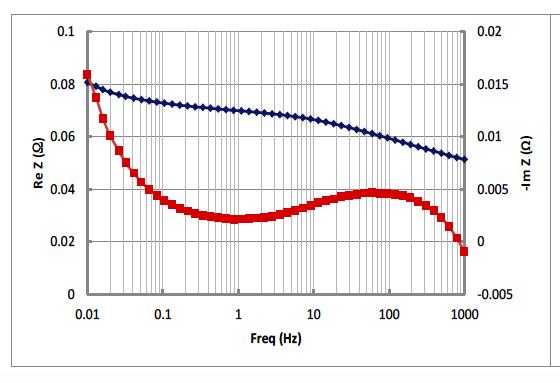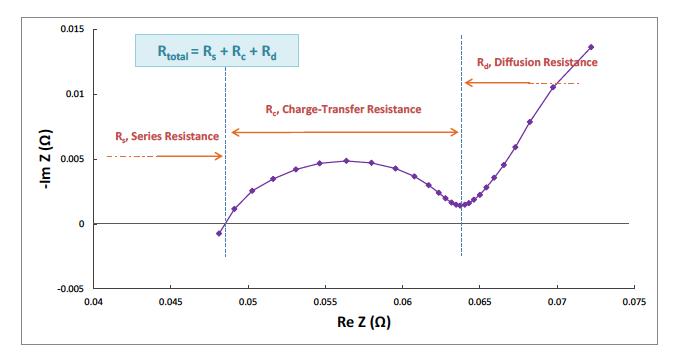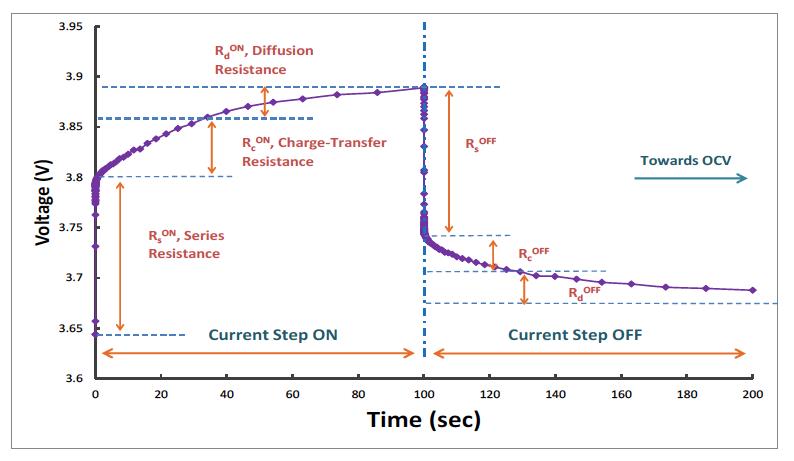Commentary Contributed by Dong Woon Kim, M.Sc., Engineer, McScience, Inc.
June 6, 2018 | Electrochemical impedance spectroscopy (EIS), also called Frequency Response Analysis (FRA), is widely used for detailed analysis of battery capability. EIS is a non-invasive technique used to assess secondary battery performance and electrochemical characteristics by measuring resistance and capacitance at various frequencies.

EIS applies an input signal to the cell to be measured at various frequencies and returns the impedance characteristics of the cell. Repeating this process over time can produce a times series of results. The typical output of an EIS test is a Bode Plot showing real and imaginary components of impedance by frequency applied.
The Nyquist plot of the same results can show internal resistance components of the cell. The high, mid and low frequency outputs are indicative of the cell’s series resistance, charge-transfer resistance and diffusion resistance respectively.
The EIS technique can provide valuable measurement and performance data about the electrochemical, resistive and capacitive behavior of a cell. However, there is a price to pay for this level of detailed information:
-

Figure 2. EIS Internal Resistance Components In a multiple cell test environment a high-quality programmable signal source is required for each cell to be tested simultaneously, leading to high system cost.
- Alternatively a multiplexer can be used with a single programmable signal source, however the tests need to be executed in series, leading to significantly longer test times, and the channel multiplexer adds to overall system cost.
- In the low frequency range the impedance measurement is highly time-consuming.
- EIS testing needs to be done independent of charge-discharge cycling, reducing the information possible if this data was available.
An alternative method for detailed cell testing is Transient Response Analysis (TRA). This method expands on the idea of DC resistance measurement of a cell by measuring resistance over varying time scales, down to microseconds. Such measurement can capture the dynamic components of the cell and also provide additional information from that provided in the EIS method.
The actual TRA method is to:
- Apply a constant current step to a cell.
- Measure the voltage response signal as a function of time.
- Calculate internal resistance with respect to time by dividing the change in voltage at a given time by the current step applied.
TR results are shown in the plots below indicating change of voltage and current over time, and to the right the high-speed dynamics of the cell with a logarithmic time scale.

While EIS testing only returns the impedance value at the measured frequency at a given state of charge (SOC), the TRA method can measure resistance by executing the current step during charge and discharge, as well as in the ‘turning on’ and ‘turning off’ steps. This produces four different types of TR results at a given SOC level, which may be able to reveal previously unknown dynamics within a cell.

Detailed metadata analysis of the TRA results can also provide equivalent internal resistance components as the EIS method, namely series resistance, charge-discharge resistance, and diffusion resistance.
Apart from the detailed information on the cell characteristics available from the TRA measurements, there are several other advantages of this method:
- Multiple time-dependent internal resistance values can be measured with a single dc current step, enabling a time-efficient inspection of the battery.
- Also dc current input can be easily coupled with charge-discharge cycling where the charging or discharging current input can be treated as the TR input current. Therefore internal resistance measurement can be performed with uninterrupted cycling.
- In a multiple cell test environment, all cells can be measured in parallel with a common logic, compared with EIS testing which requires a separate signal source for each cell under examination
Battery state of health (SOH) and lifetime prediction requires extensive evaluation of cell parameters over many charge-discharge cycles. Electrochemical impedance spectroscopy (EIS) testing provides the required data in the frequency domain, while the time domain method, transient response analysis (TRA) can provide similar if not more useful data, in a time-efficient manner and at potentially lower cost.
According to Chang Keun Bae PhD. POSTECH, Advanced Materials for Energy & Environment Laboratory in Pohang, South Korea, “TRA is a quick way of testing the battery performance with minimal interruption to the cycling. With TRA, it was possible to plan a time efficient cell performance test procedure. In addition, McScience’s automated cell tester runs with a predetermined test sequence plan so there is no need for us to monitor the tester all the time. It is a highly recommended system that is simple, efficient and precise.”
McScience have implemented the TRA measurement method in a number of battery test systems used in research and production environments. Q Series’ Q3000 systems combine both FRA and TRA methods in a common system typically used for cell research, while the Q3100 system couples TRA testing and charge-discharge cycling in a multi-cell production test system.
As secondary battery production volumes grow with increasing use of battery powered mobile and related devices, more time and cost efficient methods must also be developed to test and quality assure the imbedded cells. TRA is a more recently implemented non-invasive method for providing the data needed for this purpose.
Dong Woon Kim is a research engineer of the R&D division at McScience Inc. His team works to research, develop, and improve secondary battery parameter testing systems. His work is focused in the data management and analysis regarding the results of battery test experiments. Dong Woon has an M.Sc in Physics from Imperial College London.







